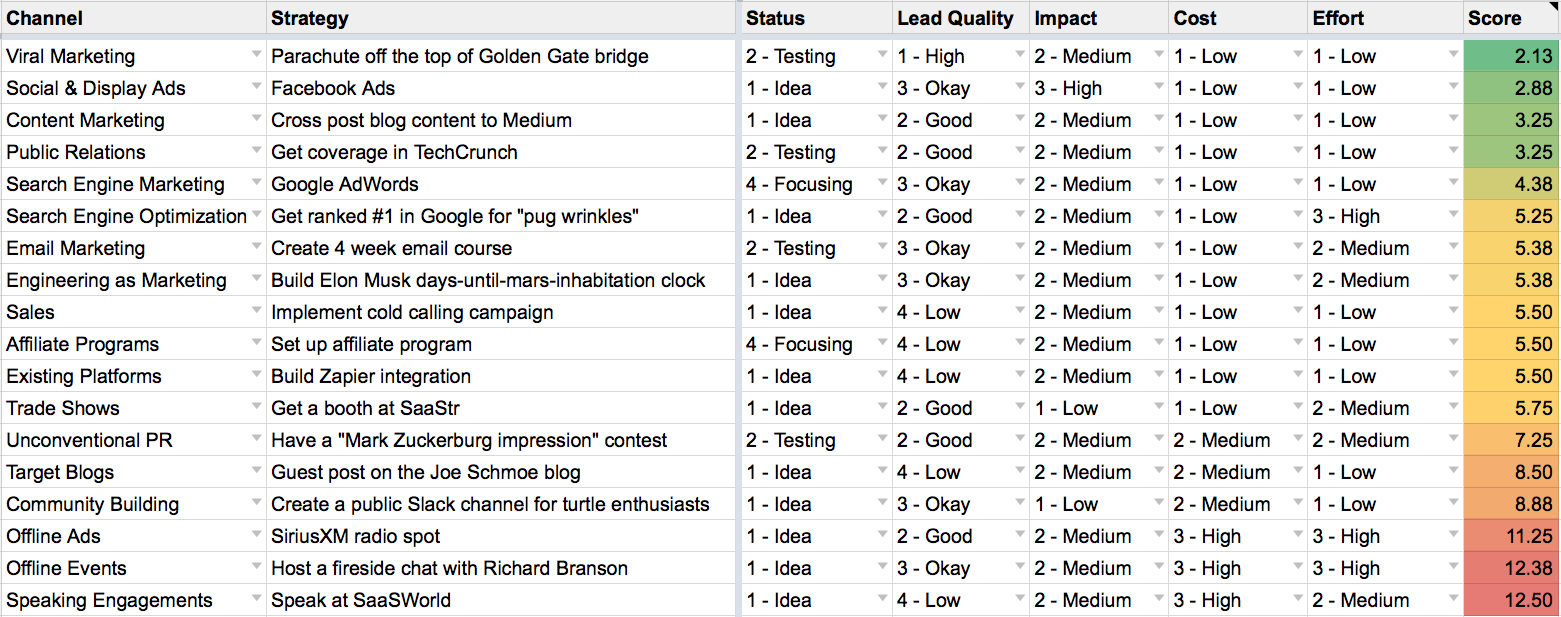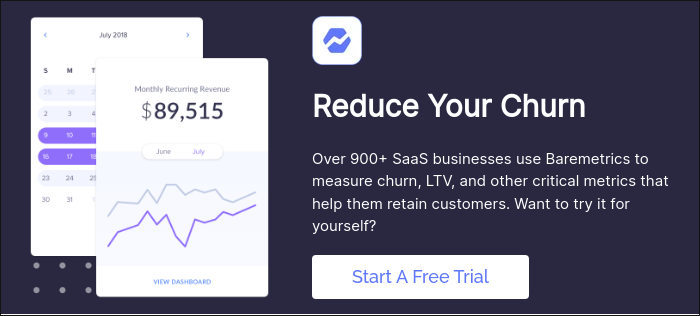Table of Contents
More Business Academy Articles
Getting new customers can feel like some sort of level 10 black magic. There seems to be no clearcut way to just identify the people who want your product, show it to them, and then have them buy it.
And while that’s mostly true, there is a way to systematically come up with marketing ideas, test them and identify the best channels for growing your customer base!
We’ve got a system we use to brainstorm new ideas, figure out what to focus on next, test that growth idea and then repeat until you’ve found a number of solid sources for new customers.
Marketing system
A while back I read a book called Traction by Gabriel Weinberg & Justin Mares. It’s jam packed full of ideas for growing your business with a framework they call “Bullseye”…highly recommended reading. The framework really is great and influenced a lot of the system we developed and now use at Baremetrics to get new customers.
Ultimately, getting new customers comes down to marketing. And I’m using the word “marketing” in very broad “making customers aware of your product” terms. If customers don’t know your product exists, then you’re up a creek.
So let’s walk through the system we use to identify marketing channels, brainstorm strategies, test those strategies and then convert users in to customers!
Channels
First, let’s talk marketing channels. Channels are essentially the various types of customer acquisition you can use. These are the basis for any ideas you’ve got. And actually just talking through these channels will likely give you a ton of ideas. Let’s walk through those 19 channels now.
- Targeting Blogs — Chances are you read and follow a number of blogs. Your customers are no different. Identify the top blogs that your customers read (which may or may not actually be in your “space”) and figure out ways to partner with or advertise on those blogs.
- Public Relations — This is the “traditional” PR you’re likely familiar with. It’s getting coverage on news outlets, magazines, TV, newspapers and the online incarnations of those media outlets.
- Unconventional PR — We just mentioned “traditional” PR…this is the non-traditional or unconventional type. It covers everything from publicity stunts to more personal things like handwritten notes to customers that leads to generated press coverage.
- Search Engine Marketing — This is, for all intents and purposes, Google AdWords. It’s paying for ads in various search engines.
- Social & Display Ads — Banner ads, Facebook ads, Twitter ads, Reddit ads. This is all the ads that you find throughout the web.
- Offline Ads — If you’re running a tech startup, it’s easy to completely thrown offline ads right out the window, but the reality is that in the grand scheme of things, more money is actually spent in offline ads that _on_line. TV, radio, newspapers, direct mail, billboards…turns out people still interact with the physical world. Who knew?!?!
- Search Engine Optimization — SEO is the process of optimizing and targeting your content towards the things your customers are searching for online. Over 5 billion searches are made every. single. day. We’re all constantly searching for things and not making your content easily accessible and findable is leaving money on the table.
- Content Marketing — Generally companies tend to fall in one of two camps: high volume but low quality content, or low volume but high quality content. Which one do you think performs better? The latter, hands down. The mere existence of a piece of content isn’t the key to making content marketing work, it’s creating content that real actual human beings want to read and share.
- Email Marketing — There’s a lot of overlap between Content and Email Marketing. Email Marketing is about delivering marketing messages and content via email in a way that connects with your customers (and potential customers) on a more personalized level.
- Viral Marketing — If you’re growing your customer base by using your current customers to refer new customers, then you’re using a viral marketing system. Companies like Dropbox, Twitter, Facebook and many others (especially in the B2C space) use viral marketing to grow.
- Engineering as Marketing — The most common example of engineering as marketing are the free tools you find on a lot of sites. We’ve done this extensively at Baremetrics with things like a Build vs. Buy calculator, a forecasting tool and an interactive industry benchmarking tool. This form of marketing is generally used as a lead generation tool to bring people in to your marketing or sales funnel and can work wonders for breaking through the noise.
- Business Development — Businesses aren’t created in a silo. They require various partnerships to really grow and business development is just the process of of creating those partnerships and relationships. The partnerships you create ultimately benefit the customer bases of both sides of the table.
- Sales — This is what you think it is. It’s the traditional process of working directly with customers to help them understand the value you’re offering in the hopes that they’re interested in buying.
- Affiliate Programs — Creating an affiliate program is essentially a way to recruit a large number of part-time sales people to help spread the word about your product. They talk about and promote your product in exchange for some type of compensation (usually cash) each time a purchase is made. This is an extremely common channel in the ecommerce world.
- Existing Platforms — One of the hardest parts of creating anything new is getting distribution. How do you get your product out there in front of lots of people who want to buy? Existing platforms can be a core way of doing that as they have built in users. Apple and Android app stores, Google’s Chrome extensions, Facebook apps…these are all massive platforms with hundreds of millions of users that you can make use of to get your product out there.
- Trade Shows — While trade shows aren’t as common in the SMB software space, they’re extremely common in the enterprise software space and basically every other industry. Physical products or products that have a longer sales cycle can benefit a lot from the right trade show as they facilitate relationships directly with the people who are buying. They can get expensive quickly, though, so you have to be careful and strategic.
- Offline Events — Event sponsorship, or even creating your own events, are similar to trade shows in that they get you in front of your target audience directly and can be cheaper and more accessible than a trade show. Vanilla event sponsorship usually isn’t great for direct conversions to new customers, but it can be great for branding. The more you can actually get involved in an event, the more payoff you’ll see from this channel.
- Speaking Engagements — Speaking engagements can be dangerous. They’re time-consuming, they usually only give you access to a relatively small group of people, and they give the illusion of doing something meaningful. Really the only time this can work well is when you’ve got an extremely targeted group of people you’re giving a talk to.
- Community Building — When you’re serving a larger market, you can create a community around what you’re doing that serves the customer well and keeps them engaged with your product. Many companies actually start with a community and then expand to create products for their community. Many companies leverage a Learning Management System (LMS) to build a community by offering valuable learning resources and interactive forums.
So, there are the 19 core marketing channels. It’s easy to write off some of these channels. “No way would a trade show ever work out for us!” But when you’re brainstorming ideas, it’s important to put it all out on the table. Mix in a scoring system for your ideas and magic!
Strategies
To get the ball rolling, you and your team should sit down and brainstorm. Go through each of the 19 marketing channels and think of all the ways you could market to customers.
These should be very specific ideas, because you’re going to test them. The more precise you are with the idea, the clearer the outcomes of your tests will be. They’ll also be cheaper to test.
Put all of your ideas in to a spreadsheet, and categorize them by channel.
Prioritization
After you’ve got at least a few dozen strategies, next up is to prioritize them. Almost all companies are strapped for resources in one way or another: team size, time, money…usually combination of all those things. You certainly can’t tackle every one of these ideas at the same time, so prioritizing what to do first is crucial.

To help you prioritize, we’ve created a scoring system based on four factors.
- Lead Quality
- Impact
- Cost
- Effort
Yes, that spells LICE, and lice makes everything nice. 😉
We use these four factors to generate a score where the lower the number, the more accessible the marketing idea is. Let’s take a look at the four factors.
Lead Quality
Not all sources are created equal. Usually your highest quality leads will come from a source that sends you the lowest number of leads and the lowest quality leads will come from a source that just hammers you with traffic.
Your AirBnB for Hamsters service may get lots of traffic from TechCrunch, but lets be honest…very few of those visitors will, you know, need that. But a writeup from Petco?!?! Those leads would be fantastic!
Impact
Impact will, many times, match up to your Lead Quality, but it’s geared more towards what the purpose of your marketing is. For instance, maybe brand awareness is a much larger focus to you as opposed to lead generation. In that case, a marketing idea could have a lower lead quality score but a high impact score.
Cost
Not all great ideas are expensive (in fact, many times your best ideas are actually dirt cheap). But the fact is, some ideas really can be pretty expensive (trade shows, advertising, sponsorships).
If cost isn’t a big factor for your company, you can lower the weight of the “cost” in the final score (which I’ll talk about momentarily).
Effort
How much work will this idea take? Does the idea rest on convincing someone else to do something? Does the whole team need to get involved to pull off the idea? All of those things affect how much effort something takes.
Multipliers
Every company is in a different stage and what factors have an impact on you will vary. Maybe you’ve got all the time in the world but no money…that makes cost a huge multiplier. Maybe you’ve got limited time but lots of money, in that case effort would be a big multiplier.
In the spreadsheet mentioned earlier, there are settings where you can adjust all four variables based on importance.
The Score
Once you’ve set Lead Quality, Effort, Cost and Impact (and adjusted the various multipliers) what you get is weighted score that helps guide what marketing ideas you should try next!
The lower the score, the more in line the idea is with the current stage of your company!
Testing
At this point you should have a spreadsheet full of ideas, all scored and automatically prioritized. Now? Time to test!
The purpose of testing is to figure out if a channel is worth spending more time, effort and money on pursuing. While the LICE score helps prioritize, the testing phase is what actually decides if a particular strategy will actually work for you.
Not all ideas are testable or even repeatable in any sort of scalable manner, but if they are, there are a number of additional data points you’ll want to track.
- Customer Acquisition Costs (CAC)
- Response Rate
- Conversion Rate
- Customer Lifetime Value (LTV)
To start a test, you need to figure out the cheapest way to stick your toe in the water to get some data around cost and conversion rates.
As an example, say Facebook ads targeting dog owners is what you want to test. You’d run a small campaign spending, say, $20 over the course of a couple of days and then analyze the results.
If you find it’s cost effective to acquire customers that way, then you can up your test. Double your spending, and then analyze the results.
Testing is not a one time thing. It’s an ongoing process that requires constant adjustment to get the most out of it. But the great thing is that as long as you’re tracking the data points mentioned above, you can always tell not only if a strategy is working for, but it’s easy to identify when a channel stops working.
Conversion
Once you’ve started driving new signups, it’s time to get them converting! This is when you start seeing a cycle to the things we’ve been teaching and the processes you’ve been putting in to place.
Many of the same things you’ve done to reduce churn, retain customers and grow your MRR all apply to actually converting users!
Just like retaining customers, converting users all comes down to engagement. When users are actively using your product during a trial period, they are exponentially more likely to become paying customers.
Work with your users to pinpoint the things that drive home the value you’re offering to them. For Baremetrics, that’s connecting a data source, which ultimately gives our users hundreds of insights they’ve either never had before or spend an inordinate amount of time getting.
Identify those things and then use one-on-one onboarding, email drip campaigns and in-app messages to help your users succeed with your product and understand the value they’re getting.




